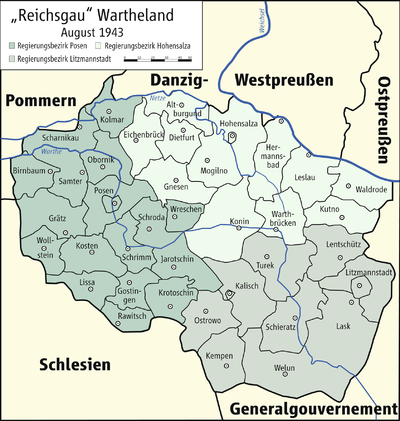Lask County

The Lask district was the name of a German administrative unit in occupied Poland (1939–45) during World War II .
Prehistory (1793 to 1807)
The area around the western Polish cities of Łask and Lutomiersk belonged temporarily to the Prussian province of South Prussia as a separate district of Lutomiersk after the Second Partition of Poland from 1793 to 1807 .
Administrative history
At the beginning of the Second World War , German troops occupied the western Polish powiat Łask , the district town of Łask was captured on September 6 and the town of Pabianice on September 8, 1939.
On October 26, 1939, the powiat was annexed to the German Reich under the name Landkreis Lask , which as a unilateral act of violence was ineffective under international law. The "district" became part of the Kalisch administrative district (from 1941: Litzmannstadt administrative district ) in the Reichsgau Wartheland .
The town of Pabianice became the seat of the German District Office . District administrator was Alfred Todt.
On November 20, 1939, the district was expanded to the east. A wide strip of the Powiat Piotrków Trybunalski located in the adjacent Generalgouvernement was also attached to the German Empire with the city of Bełchatów .
On July 1, 1940, part of the rural community of Biała from the southern neighboring district of Welun was added.
On October 1, 1943, parts of the rural communities Sędziejowice, Widawa and Zapolice were given to the western neighboring district of Schieratz .
The German occupation ended with the invasion of the Red Army in January 1945.
politics
Land Commissioner
- 1939 : cook
District administrators
- 1939–1940: Koch ( provisional )
- 1940–1942: Alfred Todt ( acting )
- 1942 : Kolb ( substitute )
- 1942–1945: Alfred Todt (1905–1961)
Municipal structure
The Lask district was divided into three municipalities ( Łask , Pabianice and Bełchatów ) and 28 rural municipalities, which were grouped together in administrative districts .
expansion
Before the expansion to Bełchatów in 1939, the Lask district had an area of 1403 km².
population
The Lask district had in 1941: 252,186 mostly Polish inhabitants.
The German occupation authorities drove over 36,000 Poles from the area between December 1, 1939 and December 31, 1943, the Jewish population was initially concentrated in ghettos and murdered in the extermination camps in Chełmno and Auschwitz from 1942 to 1944 .
A German minority had lived in the district since the beginning of the 19th century, and this was steadily increased by the additional settlement of Germans (33,790 people in 1942, about 14% of the population). After the end of the German occupation, the majority of Germans left the area again.
Place names
There were initially some "wild" Germanizations by the local occupation authorities. On May 18, 1943, all places with a post or train station were given German names, mostly phonetic adjustments, translations or free inventions.
List of cities and administrative districts in the Lask district:
| Polish name | German name (1943–1945) | Polish name | German name (1943–1945) |
|---|---|---|---|
| Bałucz | Balau | Łękawa |
1939–1943 Lenkawa 1943–1945 Lenkau |
| Bełchatów | Belchental | Lutomiersk | Nertal |
| Buczek | Buscheck | Pabianice |
1939–40 Burgstadt 1940–1945 Pabianitz |
| Bujny Szlacheckie | Bujny Szlacheckie | Pruszków | Prushkov |
| Chobielice | Hablach | Rusiec | Rustitz |
| Chociw | Chociw | Sędziejowice | Sendewitz |
| Dłutów | Zielkental | Suchcice | Search stone |
| Dobroń | Dobberwalde | Szczerców | Joke |
| Górka Pabianicka | Gorka Pabianicka | Wadlew | Wadlau |
| Grabica | Grebitz | Widawa | Wiedenbruch |
| Holendry Paprockie | Holendry Paprockie | Widzew | Widzew |
| Kleszczów | Klestau | Sulmierzyce |
1939–1943 Sulmingen 1943–1945 Sulmers |
| Kluki | Klucksdorf | Wygiełzów | Cradle |
| Łask | Lask | Zelów | Sellau |
See also
Web links
- Lask administrative history and the district administrators on territorial.de (Rolf Jehke), as of August 20, 2013.
Individual evidence
- ↑ Jochen Böhler , Stephan Lehnstaedt (ed.): Violence and everyday life in occupied Poland 1939–1945 (= individual publications by the German Historical Institute Warsaw; 26). Fiber, Osnabrück 2012, ISBN 978-3-938400-70-8 , pp. 195f